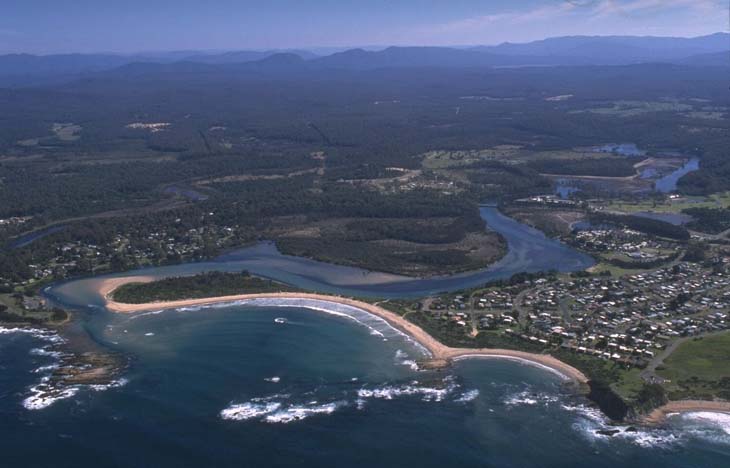Tomaga River is a barrier river estuary with an open entrance. It is located on the south coast of New South Wales, south of Batemans Bay.
The estuary hosts a range of habitats such as intertidal mudflats, mangrove forests, saltmarshes, swamp-oak woodlands and is a habitat protection zone as part of Batemans Marine Park.
Water quality report card
As part of our water quality monitoring program we assess the water quality and ecosystem health of an estuary using a range of relevant indicators. We sample a subset of the estuaries between Wollongong and the Victorian border every 3 years. The most recent sampling in the Tomaga River was completed over the 2008–09 summer when 2 sites were sampled on a monthly basis.
This report card represents 2 water quality indicators that we routinely measure: the amount of algae present and water clarity. Low levels of these 2 indicators equate with good water quality.
Algae
Water clarity
Overall grade
The report card shows the condition of the estuary was excellent with:
- algae abundance graded excellent (A)
- water clarity graded excellent (A)
- overall estuary health graded excellent (A).
Grades for algae, water clarity and overall are represented as:
- A – excellent
- B – good
- C – fair
- D – poor
- E – very poor.
Eurobodalla Shire Council have a long-term water quality monitoring program in the Tomaga River, based on the same sampling and reporting methods as our state-wide program. The results of the monitoring program, including a detailed water quality report card, are available on the Eurobodalla Shire Council website.
Go to estuary report cards to find out what each grade means, read our sampling, data analysis and reporting protocols, and find out how we calculate these grades.
Physical characteristics
| Estuary type | Barrier river |
|---|---|
| Latitude (ºS) | –35.84 |
| Longitude (ºE) | 150.19 |
| Catchment area (km2) | 91.9 |
| Estuary area (km2) | 1.8 |
| Estuary volume (ML) | 1410.9 |
| Average depth (m) | 1 |
Tidal exchange volume
Tidal exchange volume or tidal prism data is available for this estuary.
| Tide state | Flow (ML) | Local tidal range (m) | Sydney Harbour tidal range (m) |
|---|---|---|---|
| Ebb flow | 960 | 0.86 | 1.09 |
| Flood flow | 960 | 0.9 | 1.15 |
Notes: km2 = square kilometres; m = metres; m3 = cubic metres; ML = megalitres.
Water depth and survey data
Bathymetric and coastal topography data for this estuary are available in our data portal.
Land use
The Tomago River catchment is moderately disturbed with almost 20% cleared for urban and rural residential areas and grazing at Tomakin, Mogo and Woodlands. About 80% of the catchment is forested.
National and marine parks
- There is no conservation area in the Tomaga River catchment area.
- The Tomaga River estuary flows into Batemans Marine Park.
Citizen science projects
- iNaturalist’s Plants of Eurobodalla is a citizen science project that monitors plants found in the Eurobodalla region.
- The Budawang Coast Nature Map is an online data platform the community can use to record and identify biodiversity. Data collected is used to map the distribution of native plant and animal species from Moruya up almost to Kiama.
Community involvement
- Eurobodalla Landcare is a volunteer network of 24 Landcare groups on the New South Wales south coast.
- The Coastwatchers Association is a community environmental and conservation group based on the south coast.

Aerial view of Tomaga River estuary.
Local government management
Local councils manage estuaries within their area unless the estuary is attached to a marine park.
Eurobodalla Shire Council manage this estuary, which is located in Batemans Marine Park.
Threatened species
Threatened shorebird species, such as the pied oyster catcher and hooded plover, can be found along the river and feed in the lower estuary.
Read more about the biodiversity in our estuaries.